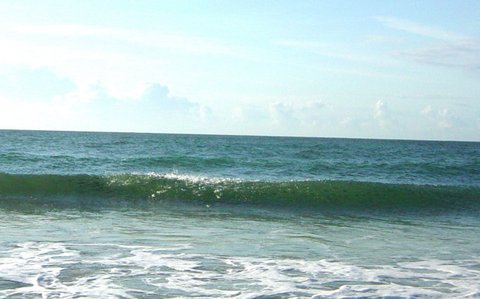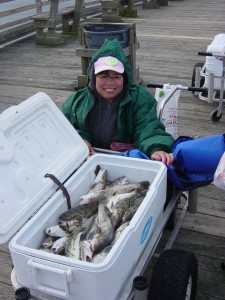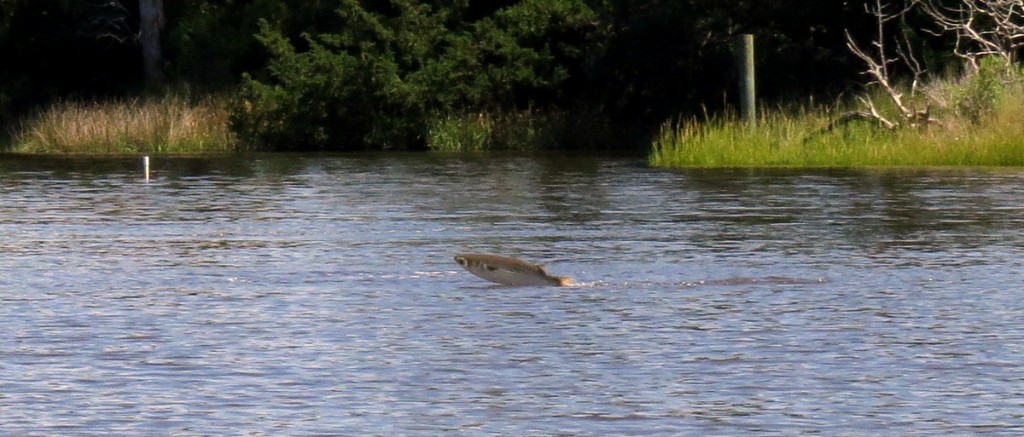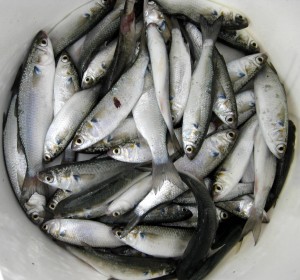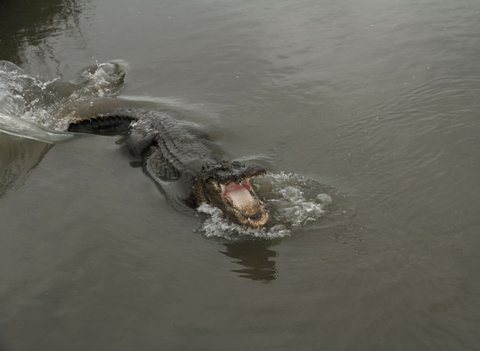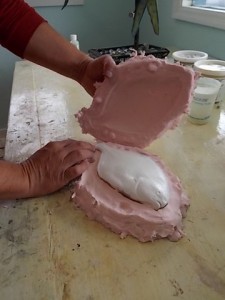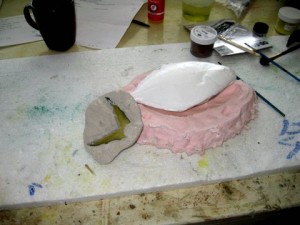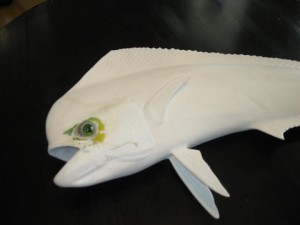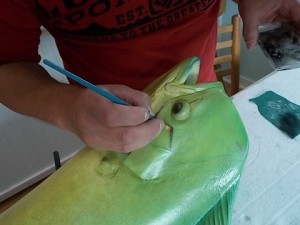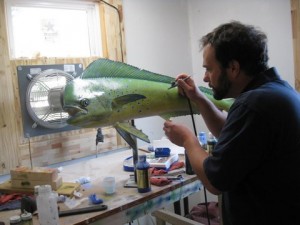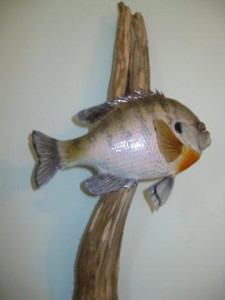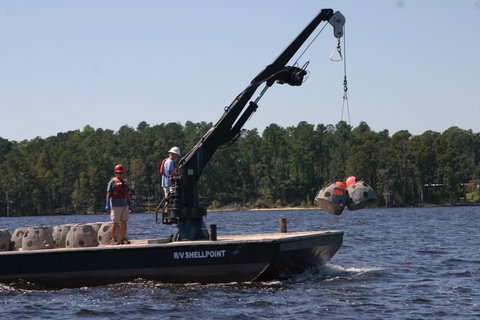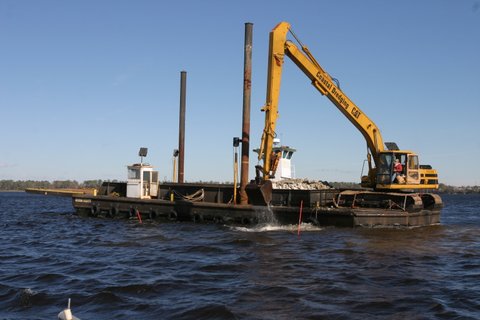Lions and Tigers oh my: The “alien” invasion by Dr. Bogus
Hold onto your hat Batman, beware of the alien invasion! No they are not critters from outer space or refugees from Area 51 or Roswell, New Mexico, but according to Dr. James Morris from the NOAA Labs in Beaufort, NC, the invasion of lionfish is well underway.
So what is an invasive species and where DID they come from? According to Morris, “Invasive species are essentially organisms that invade a new area; they are not from that area, explained Morris. They can cause ecological harm or economic harm or both and many times it is both.”
Just think about it, over the past years we have heard about the accidental introduction of the of zebra mussels into the Great Lakes, kudzu all over the countryside and the likes of the aggressive snakehead fish and leaping carp to our rivers, as well as fire ants and even the dreaded killer bees.
“We now live in a global marketplace,” said Morris, “and you look at the transport of goods and commodities all over the world, and there’s plenty of pathways…air travel as well as ocean travel, which can wreak havoc in many ways in terms of the transfer of organisms all over our planet. The number of invasive species has been really ramping up in the last 50 to 100-years. We have hitchhikers, but we also have organisms that are on-purpose transplanted from one area to another.” Think Kudzu!
But the invaders that we will deal with at this time are marine species, the lionfish and the Asian tiger shrimp. First the lionfish, an ornamental tropical fish from the Indian and Pacific Oceans and very popular in the aquarium trade, from whence it was probably initially introduced into the waters of south Florida.
According to Morris, discovery of the lionfish in south Florida waters dates back to 1985, but was initially discovered in the offshore wrecks of North Carolina in 2000 by Paula Whitfield (NOAA) and others, essentially marking the beginning of the establishment phase of lionfish in North Carolina.
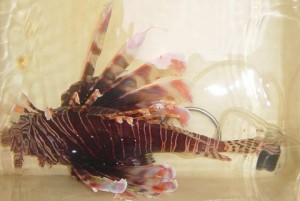 “It has really become a poster child for invasive species to be honest with you,” explained Morris, “there are so many, even school kids now recognize as a non-native species. It’s a brilliantly colored fish is beautifully ornate, spectacular, and for that reason we have been importing that species in the thousands into the US. But now it is thriving along the southeast US in less than a decade became established in hundreds per acre in some coral reef habitats and some hard bottom habitats in the southeast, the Caribbean and it’s presently invading the Gulf of Mexico. We don’t’ expect this fish to really stop its invasion until it reaches the waters of South America, probably Northern Argentina.”
“It has really become a poster child for invasive species to be honest with you,” explained Morris, “there are so many, even school kids now recognize as a non-native species. It’s a brilliantly colored fish is beautifully ornate, spectacular, and for that reason we have been importing that species in the thousands into the US. But now it is thriving along the southeast US in less than a decade became established in hundreds per acre in some coral reef habitats and some hard bottom habitats in the southeast, the Caribbean and it’s presently invading the Gulf of Mexico. We don’t’ expect this fish to really stop its invasion until it reaches the waters of South America, probably Northern Argentina.”
Why will it stop at northern Argentina? Temperature, the lethal minimum temperature, according to Morris is about 50-degrees Fahrenheit. “So although the Gulf Stream has carried larva and juvenile fish even as far north as Long Island and New England,” said Morris, “but north of the Virginia-North Carolina line, it gets too cold for those tropical to overwinter. So Lionfish, like other tropicals just literally perish in the winter. They just can’t stand the cold.”
So after more than a decade, it looks like the visually spectacular lionfish are here to stay, and are indeed thriving, not just surviving. In fact these days, lionfish are abundant enough to be routinely caught on hook-and-line by fishermen fishing our offshore waters while looking for coveted grouper, snapper and other tasty bottom dwellers and also regularly encountered by divers reconnoitering our famous offshore reefs and wrecks.
What about natural predators to keep them in check? “The natural predation story is a little interesting,” sighed Morris, “we really do not know of a natural predator even in their native range, although there have been only some anecdotal observations. Here in the Atlantic we have seen a number of our native species that are eating lionfish, but not regularly, we only have sporadic observations. To really be a natural predator you have to impose predation mortality that’s significant enough to reduce the densities that we see on the reefs. You know this is a venomous fish…it has evolved a venom defense system that works!”
So HOW venomous is the lionfish? First, according to Morris, the venom glands are in grooves along the side of the spines so that is when the spine punctures something, the skin around the spine is torn back and that releases the venom. It’s a passive venom delivery system, there’s no pressure or vacuole shooting it out. That is where and how, but really HOW poisonous is the venom.
“The venom is a very potent venom,” exclaimed Morris, “scorpionfish get their name for a reason, and the reaction to envenomation (getting stung) can range anywhere from mild to extreme pain, to blisters, we’ve even had one case of a person that was stung in an aquarium recently actually had paralysis of his arms and his legs for four- to- five-hours. And there are some very extreme and rare cases of people actually dying from lionfish stings. Most of these of course come from the Pacific (Ocean). I haven’t heard of anyone dying at all in the Atlantic. But people die from bee stings and wasp stings as well. But you have to throw that in there, put that in perspective.”
So, they are venomous, they don’t have any natural predators and they are thriving. The next question to Dr. Morris, was, is there any hope of, if not exterminating the lionfish at least controlling their spread or are they destined to take over our offshore reefs to the exclusion of our economically important reef fish like grouper, snapper, triggerfish and sea bass? Maybe the answer is…if you can’t beat ‘em, eat ‘em!
“There have been lots of efforts to get this fish on the market,” said Morris, “there is so much interest there. This is a scorpionfish which we know is the basis for many French and Mediterranean cuisines. There are scorpionfish all over. We (in the US) harvest literally tons of “rock fishes” on the west coast, and those are also a scorpionfish. They have the same venom system as lionfish. And there had been interest from day-one; could this species be harvested as a fishery? We don’t think that we can harvest them into extinction, that’s just not possible. But in the same light we do need a solution to how to control this invasion in some areas. One problem is that there is really no good way of catching them selectively. We’re working on some trapping methods, but right now we’re still working on that.”
Maybe you can develop a good way to catch the lionfish commercially, but will the public go for it, so how do they taste? Morris has filleted them and eaten them so how do they taste? “They taste really good of course,” smiled Morris, “they have a nice white flaky meat, like many of our grouper and snapper species. Of course they are feeding on many of the same things that snapper and grouper are feeding on, so they taste like a reef fish and they taste good.”
And since only the spines are venomous, there is generally not a problem with eating fish meat, the venom is NOT in the meat, it’s just white, flaky and tasty. Maybe they taste just like turkey, which is another name for the lionfish…turkeyfish!
Another invasive species that is definitely edible is the Asian tiger shrimp. They have also been in the newspapers lately highlighting some of our local commercial shrimpers that have been catching them in their shrimp trawls. Consider for a minute, holding in your hand an enormous foot-long quarter- pound shrimp! So what’s the history about that invader?
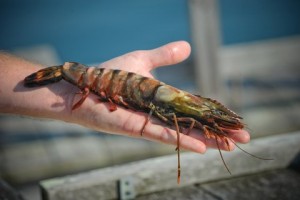 “This one has been really interesting problem,” said Morris. “I grew up shrimping in Core Sound and Pamlico Sound and I’ve always been fascinated by shrimp and the shrimp fisheries. When I first saw this shrimp and held it in my hands I was amazed at its size. This shrimp gets up to two- or three-count, it’s like a quarter of a pound. It’s called the Asian tiger shrimp and it’s very common in shrimp aquiculture. Some people call them tiger prawns. It has been a staple in the shrimp aquiculture industry in the Caribbean for years,” explained Morris.
“This one has been really interesting problem,” said Morris. “I grew up shrimping in Core Sound and Pamlico Sound and I’ve always been fascinated by shrimp and the shrimp fisheries. When I first saw this shrimp and held it in my hands I was amazed at its size. This shrimp gets up to two- or three-count, it’s like a quarter of a pound. It’s called the Asian tiger shrimp and it’s very common in shrimp aquiculture. Some people call them tiger prawns. It has been a staple in the shrimp aquiculture industry in the Caribbean for years,” explained Morris.
The question then is then, are there Asian tiger shrimp farms in the US that could account for their presence? According to Morris, there used to be farms in the US, there are no active shrimp farms that farm this species currently.
“We have been tracking this species really for about 10- or 12-years,” explained Morris, “and for some reason, in 2011, this past summer we saw a rapid increase in the number of sightings and collections along the southeast US.”
Could this increase be related to last year’s Hurricane Irene?
“Probably not,” said Morris, “because we are seeing the same increase in the Gulf (of Mexico) too.” “We’ll have to see coming up in the next year or two. If we continue to see the increase that we’re seeing in 2011, they may be self-reproducing and we may be undergoing a complete establishment of this non-native species of shrimp.”
We’ve talked about the potential problems of the lionfish, but how about the potential impact of establishment of the Asian tiger shrimp in our coastal waters?
“Just like the lionfish,” said Morris, “we are concerned about the ecological impacts of this invasion.” “We have to remember that we are very young to understanding the impacts of marine invasive species. We don’t really have that many examples. The lionfish is really the first marine fish to invade the southeast and Gulf and Caribbean, so like lionfish we really don’t know what will be the consequences of this invasion. One thing we do know is that this shrimp species gets much larger than any of our native shrimp species. It actually can become carnivorous once it gets larger and it eats other small shrimp, and small fish, even so the consequences of this invasion are really unknown, but we anticipate that there may be food-web related consequences which can have a long list of concerns.”
So you put a quarter pound carnivorous shrimp in the food web you don’t know where and what it impacts.
“Absolutely,” said Morris, “the realm of possibilities is everything from no observed or no detectable ecological impact to extreme ecological impact such as a complete disruption of the food web and competition with our native shrimp species.”
So can we eat this one into submission too? Get a viable marine, not farm based commercial industry?
“All things are possible with this one;” explained Morris, “it is farmed as an edible species that is grown commercially around the world, we know it obviously tastes good. But there aren’t enough of them being landed now; we’re only talking hundreds of shrimp of this species being seen, so we are a long way from it potentially being a resource. And it’s one that we’ll be following closely.”
Closely indeed, so keep your eyes open in your favorite restaurants for “turkeyfish of the sea” and maybe “Atlantic Ocean” tiger prawns!
NOTE: Recently the FDA has shown that some lionfish samples tested positive for the toxin that can causes ciguatera, a potentially dangerous fish food poisoning often found in reef fish and has recommended against eating the fish. However, so far, there are no known confirmed cases of ciguatera in the U.S. that have implicated the lionfish.

